Ecological Synthesis of CuO Nanoparticles Using Punica granatum L. Peel Extract for the Retention of Methyl Green
Abstract
:1. Introduction
2. Materials and Methods
2.1. Chemicals
2.2. Extract Preparation
2.3. Chemical Composition of Punica granatum Bark
2.4. CuO Nanoparticles Biosynthesis
2.5. Methyl Green Adsorption on CuO Nanoparticles
2.6. Characterization Techniques
3. Results and Discussion
3.1. Characterization of Punica granatum Bark
3.2. Preparation and Characterization of CuO Nanoparticles
3.3. Study of the Adsorption of Methyl Green on CuO Nanoparticles
3.3.1. Influence of pH, Adsorbent Dose and Contact Time on the Methyl Green Adsorption onto CuO Nanoparticles
3.3.2. Kinetic Study
3.3.3. Adsorption Isotherms
3.3.4. Desorption and Adsorbent Reuse
4. Conclusions
Author Contributions
Funding
Institutional Review Board Statement
Informed Consent Statement
Data Availability Statement
Acknowledgments
Conflicts of Interest
References
- Kazemzadeh, Y.; Shojaei, S.; Riazi, M.; Sharifi, M. Review on application of nanoparticles for EOR purposes: A critical review of the opportunities and challenges. Chin. J. Chem. Eng. 2019, 27, 237–246. [Google Scholar] [CrossRef]
- Yasmin, M. Compressive Strength Prediction for Concrete Modified with Nanomaterials. Case Stud. Constr. Mater. 2021, 15, e00660. [Google Scholar]
- Azhdarzadeh, M.; Saei, A.; Sharifi, A.S.; Hajipour, M.J.; Alkilany, A.M.; Sharifzadeh, M.; Ramazani, F.; Laurent, S.; Mashaghi, A.; Mahmoudi, M. Nanotoxicology: Advances and pitfalls in research methodology. Nanomedicine 2015, 10, 2931–2952. [Google Scholar] [CrossRef] [PubMed] [Green Version]
- Nakamura, S.; Sato, M.; Sato, Y.; Ando, N.; Takayama, T.; Fujita, M.; Ishihara, M. Synthesis and Application of Silver Nanoparticles (Ag NPs) for the Prevention of Infection in Healthcare Workers. Int. J. Mol. Sci. 2019, 20, 3620. [Google Scholar] [CrossRef] [Green Version]
- Garnett, M.C.; Kallinteri, P. Nanomedicines and nanotoxicology: Some physiological principles. Occup. Med. 2006, 565, 307–311. [Google Scholar] [CrossRef] [Green Version]
- Ben Mosbah, M.; Lassaad, M.; Khiari, R.; Moussaoui, Y. Current State of Porous Carbon for Wastewater Treatment. Processes 2020, 8, 1651. [Google Scholar] [CrossRef]
- Hamad, H.T.; Al-Sharify, Z.T.; Al-Najjar, S.Z.; Gadooa, Z.A. A review on nanotechnology and its applications on Fluid Flow in agriculture and water recourses. IOP Conf. Ser. Mater. Sci. Eng. 2020, 870, 012038. [Google Scholar] [CrossRef]
- Xavier, M.; Parente, I.; Rodrigus, P.; Cerqueira, M.A.; Pastrana, L.; Gonçalves, C. Safety and fate of nanomaterials in food: The role of in vitro tests. Trends Food Sci. Technol. 2021, 109, 593–607. [Google Scholar] [CrossRef]
- Huang, Z.; Wang, X.; Sun, F.; Fan, C.; Sun, Y.; Jia, F.; Yin, G.; Zhou, T.; Liu, B. Super response and selectivity to H2S at room temperature based on CuO nanomaterials prepared by seed-induced hydrothermal growth. Mater. Des. 2021, 201, 109507. [Google Scholar] [CrossRef]
- Pathakoti, K.; Manubolu, M.; Hwang, H.M. Nanostructures: Current uses and future applications in food science. J. Food Drug Anal. 2017, 25, 245–253. [Google Scholar] [CrossRef] [Green Version]
- Tian, X.; Fan, T.; Zhao, W.; Abbas, G.; Han, B.; Zhang, K.; Li, N.; Liu, N.; Liang, W.; Huang, H.; et al. Recent advances in the development of nanomedicines for the treatment of ischemic stroke. Bioact. Mater. 2021, 6, 2854–2869. [Google Scholar] [CrossRef] [PubMed]
- Hafiz, M.; Talhami, M.; Ba-Abbad, M.M.; Hawari, A.H. Optimization of Magnetic Nanoparticles Draw Solution for High Water Flux in Forward Osmosis. Water 2021, 13, 3653. [Google Scholar] [CrossRef]
- Marouzi, S.; Sabouri, Z.; Darroudi, M. Greener synthesis and medical applications of metal oxide nanoparticles. Ceram. Int. 2021, 47, 19632–19650. [Google Scholar] [CrossRef]
- Satyanarayana, T.; Reddy, S.S. A Review on Chemical and Physical Synthesis Methods of Nanomaterials. Int. J. Res. Appl. Sci. Eng. Technol. 2018, 6, 2885–2889. [Google Scholar] [CrossRef]
- Ubaidullah, M.; Al-Enizi, A.M.; Shaikh, S.; Ghanem, M.A.; Mane, R.S. Waste PET plastic derived ZnO@NMC nanocomposite via MOF-5 construction for hydrogen and oxygen evolution reactions. J. King Saud Uni. Sci. 2020, 32, 2397–2405. [Google Scholar] [CrossRef]
- Yakoot, S.M.; Salem, N.A. A Sonochemical-assisted Simple and Green Synthesis of Silver Nanoparticles and its Use in Cosmetics. Int. J. Pharmacol. 2016, 12, 572–575. [Google Scholar] [CrossRef]
- Sahoo, M.; Vishwakarma, S.; Panigrahi, C.; Kumar, J. Nanotechnology: Current applications and future scope in food. Food Front. 2021, 2, 3–22. [Google Scholar] [CrossRef]
- Singh, H. Nanotechnology applications in functional foods; opportunities and challenges. Prev. Nutr. Food Sci. 2016, 21, 1–8. [Google Scholar] [CrossRef]
- Naseem, T.; Farrukh, M.A. Antibacterial Activity of Green Synthesis of Iron Nanoparticles Using Lawsoniainermis and Gardenia jasminoides Leaves Extract. J. Chem. 2015, 2015, 912342. [Google Scholar] [CrossRef] [Green Version]
- Manjare, S.B.; Pendhari, P.D.; Badade, S.M.; Thopate, S.R. Palladium Nanoparticles: Plant Aided Biosynthesis, Characterization, Applications. Chem. Afr. 2021, 4, 715–730. [Google Scholar] [CrossRef]
- Siddiqui, S.; Alrumman, S.A. Influence of nanoparticles on food: An analytical assessment. J. King Saud Uni. Sci. 2021, 33, 101530. [Google Scholar] [CrossRef]
- Suwalsky, M.; Vargas, P.; Avello, M.; Villena, F.; Sotomayor, C.P. Human erythrocytes are affected in vitro by flavonoids of Aristotelia chilensis (Maqui) leaves. Int. J. Pharm. 2008, 363, 85–90. [Google Scholar] [CrossRef] [PubMed]
- Naikoo, G.A.; Mustaqeem, M.; Hassan, I.U.; Awan, T.; Arshad, F.; Salim, H.; Qurashi, A. Bioinspired and green synthesis of nanoparticles from plant extracts with antiviral and antimicrobial properties: A critical review. J. Saudi Chem. Soc. 2021, 25, 101304. [Google Scholar] [CrossRef]
- Makul, N.; Fediuk, R.; Amran, M.; Al-Akwaa, M.S.; Pralat, K.; Nemova, D.; Petropavlovskii, K.; Novichenkova, T.; Petropavlovskaya, V.; Sulman, M. Utilization of Biomass to Ash: An Overview of the Potential Resources for Alternative Energy. Materials 2021, 14, 6482. [Google Scholar] [CrossRef]
- Mora-Sandí, A.; Ramírez-González, A.; Castillo-Henríquez, L.; Lopretti-Correa, M.; Vega-Baudrit, J.R. Persea Americana Agro-Industrial Waste Biorefinery for Sustainable High-Value-Added Products. Polymers 2021, 13, 1727. [Google Scholar] [CrossRef]
- Shahrashoub, M.; Bakhtiari, S.; Afroosheh, F.; Googheri, M.S. Recovery of iron from direct reduction iron sludge and biosynthesis of magnetite nanoparticles using green tea extract. Colloids Surf. A Physicochem. Eng. Asp. 2021, 622, 126675. [Google Scholar] [CrossRef]
- Ajayi, A.; Larayetan, R.; Yahaya, A.; Falola, O.O.; Ude, N.A.; Adamu, H.; Oguche, S.M.; Abraham, K.; Egbagba, A.O.; Egwumah, C.; et al. Biogenic Synthesis of Silver Nanoparticles with Bitter Leaf (Vernonia amygdalina) Aqueous Extract and Its Effects on Testosterone-InducedBenign Prostatic Hyperplasia (BPH) in Wistar Rat. Chem. Afr. 2021, 4, 791–807. [Google Scholar] [CrossRef]
- Ighalo, J.O.; Sagboye, P.A.; Umenweke, G.; Ajala, O.J.; Omoarukhe, F.O.; Adeyanju, C.A.; Ogunniyi, S.; Adeniyi, A.G. CuO nanoparticles (CuO NPs) for water treatment: A review of recent advances. Environ. Nanotechnol. Monit. Manag. 2021, 15, 100443. [Google Scholar] [CrossRef]
- Nayak, R.; Ali, F.A.; Mishra, D.K.; Ray, D.; Aswal, V.K.; Sahoo, S.K.; Nanda, B. Fabrication of CuO nanoparticle: An efficient catalyst utilized for sensing and degradation of phenol. J. Mater. Res. Technol. 2020, 9, 11045–11059. [Google Scholar] [CrossRef]
- Baylan, N.; Ilalan, I.; Inci, I. Copper oxide nanoparticles as a novel adsorbent for separation of acrylic acid from aqueous solution: Synthesis, characterization, and application. Water Air Soil Pollut. 2020, 231, 1–15. [Google Scholar] [CrossRef]
- Sharifpour, E.; AlipanahpourDil, E.; Asfaram, A.; Ghaedi, M.; Goudarzi, A. Optimizing adsorptive removal of malachite green and methyl orange dyes from simulated wastewater by Mn-doped CuO-Nanoparticles loaded on activated carbon using CCD-RSM: Mechanism, regeneration, isotherm, kinetic, and thermodynamic studies. Appl. Organomet. Chem. 2019, 33, e4768. [Google Scholar]
- Kumar, K.Y.; Archana, S.; Vinuth Raj, T.N.; Prasana, B.P.; Raghu, M.S.; Muralidhara, H.B. Superb adsorption capacity of hydrothermally synthesized copper oxide and nickel oxide nanoflakes towards anionic and cationic dyes. J. Sci. Adv. Mater. Devices 2017, 2, 183–191. [Google Scholar] [CrossRef]
- Darwish, A.; Rashad, M.; AL-Aoh, H.A. Methyl orange adsorption comparison on nanoparticles: Isotherm, kinetics, and thermodynamic studies. Dye. Pigm. 2019, 160, 563–571. [Google Scholar] [CrossRef]
- Zaman, M.B.; Poolla, R.; Singh, P.; Gudipati, T. Biogenic synthesis of CuO Nanoparticles using Tamarindus indica L. and a study of their photocatalytic and antibacterial activity. Environ. Nanotechnol. Monit. Manage. 2020, 14, 100346. [Google Scholar] [CrossRef]
- Anand, G.T.; Sundaram, S.J.; Kanimozhi, K.; Nithiyavathi, R.; Kaviyarasu, K. Microwave assisted green synthesis of CuO nanoparticles for environmental applications. Mater. Today Proc. 2021, 36, 427–434. [Google Scholar] [CrossRef]
- Xi, J.; He, L.; Yan, L.-g. Continuous extraction of phenolic compounds from pomegranate peel using high voltage electrical discharge. Food Chem. 2017, 230, 354–361. [Google Scholar] [CrossRef]
- Hasnaoui, N.; Wathelet, B.; Jiménez-Araujo, A. Valorization of pomegranate peel from 12 cultivars: Dietary fiber composition, antioxidant capacity and functional properties. Food Chem. 2014, 160, 196–203. [Google Scholar] [CrossRef]
- El-Hadary, A.E.; Taha, M. Pomegranate peel methanolic-extract improves the shelf-life of edible-oils under accelerated oxidation conditions. Food Sci. Nutr. 2020, 8, 1798–1811. [Google Scholar] [CrossRef]
- Wise, L.E.; Murphy, M. Chlorite holocellulose, its fractionation and bearing on summative wood analysis and studies on the hemicelluloses. Pap. Trade J. 1946, 122, 35–43. [Google Scholar]
- Langmuir, I. The adsorption of gases on plan surfaces of glass, mica and platinum. J. Am. Chem. Soc. 1918, 40, 1361–1403. [Google Scholar] [CrossRef] [Green Version]
- Freundlich, H.M.F. Uber die adsorption in losungen. Z. Phys. Chem. 1906, 57, 385–470. [Google Scholar] [CrossRef]
- Temkin, M.J.; Pyzhev, V. Recent Modifications to Langmuir Isotherms. ActaPhysiochimca URSS 1940, 12, 217–225. [Google Scholar]
- Dubinin, M.M.; Radushkevich, L.V. Equation of the Characteristic Curve of Activated Charcoal. Proc. USSR Phys. Chem. 1947, 55, 331–333. [Google Scholar]
- Bendahou, A.; Dufrense, A.; Kaddamia, H.; Habibi, Y. Isolation and structural characterization of hemicelluloses from palm of Phoenix dactylifera L. Carbohydr. Polym. 2007, 68, 601–608. [Google Scholar] [CrossRef]
- Khiari, R.; Mhini, M.F.; Belgacem, M.N.; Mauret, E. Chemical composition and pulping of date palm rachis and Posidonia oceanica—A comparison with other wood and non-wood fibre sources. Bioresour. Technol. 2010, 101, 775–780. [Google Scholar] [CrossRef]
- M’barek, I.; Slimi, H.; AlSukaibi, A.K.D.; Alimi, F.; Lajimi, R.H.; Mechi, L.; Bensalem, R.; Moussaoui, Y. Cellulose from Tamarixaphylla’s stem via acetocell for cadmium adsorption. Arab. J. Chem. 2022, 15, 103679. [Google Scholar] [CrossRef]
- Mechi, N.; Khiari, R.; Elaloui, E.; Belgacem, M.N. Preparation of paper sheets from cellulosic fibres obtained from Prunus Amygdalus and Tamarisk SP. Cellul. Chem. Technol. 2016, 50, 863–872. [Google Scholar]
- Samar, M.; Khiari, R.; Bendouissa, N.; Saadallah, S.; Mhenni, F.; Mauret, E. Chemical composition and pulp characterization of Tunisian vine stems. Ind. Crops Prod. 2012, 36, 22–27. [Google Scholar]
- Mannai, F.; Ammar, M.; Yanez, J.G.; Elaloui, E. Alkaline Delignification of Cactus Fibres for Pulp and Papermaking Applications. J. Polym. Environ. 2018, 26, 798–806. [Google Scholar] [CrossRef]
- Saad, S.; Dávila, I.; Mannai, F.; Labidi, J.; Moussaoui, Y. Effect of the autohydrolysis treatment on the integral revalorisation of Ziziphus lotus. Biomass Conv. Bioref. 2022, 1–13. [Google Scholar] [CrossRef]
- Jimenez, L.; Sanchez, I.; Lopez, F. Olive wood as a raw material for paper manufacture. Tappi J. 1992, 75, 89–91. [Google Scholar]
- Ferhi, F.; Das, S.; Moussaoui, Y.; Elaloui, E.; Yanez, J.G. Paper from Stipagrostis pungens. Ind. Crops Prod. 2014, 59, 109–114. [Google Scholar] [CrossRef]
- Moussaoui, Y.; Ferhi, F.; Elaloui, E.; Bensalem, R.; Belgacem, M.N. Utilisation of Astragalus Armatus roots in papermaking. Bioresources 2011, 6, 4969–4978. [Google Scholar]
- Ferhi, F.; Dass, S.; Elaloui, E.; Moussaoui, Y.; Yanz, J.G. Chemical characterisation and suitability for papermaking applications studied on four species naturally growing in Tunisia. Ind. Crops Prod. 2014, 61, 180–185. [Google Scholar] [CrossRef]
- Benchagra, L.; Berrougui, H.; Islam, M.O.; Ramchoun, M.; Boulbaroud, S.; Hajjaji, A.; Fulop, T.; Ferretti, G.; Khalil, A. Antioxidant Effect of Moroccan Pomegranate (Punica granatum L. Sefri Variety) Extracts Rich in Punicalag in against the Oxidative Stress. Process. Foods 2021, 10, 2219. [Google Scholar]
- Sanhueza, L.; García, P.; Giménez, B.; Benito, J.M.; Matos, M.; Gutiérrez, G. Encapsulation of Pomegranate Peel Extract (Punica granatum L.) by Double Emulsions: Effect of the Encapsulation Method and Oil Phase. Foods 2022, 11, 310. [Google Scholar] [CrossRef]
- Mannai, F.; Elhleli, H.; Ammar, M.; Passas, R.; Elaloui, E.; Moussaoui, Y. Green process for fibrous networks extraction from Opuntia (Cactaceae): Morphological design, thermal and mechanical studies. Industrial. Ind. Crops Prod. 2018, 126, 347–356. [Google Scholar] [CrossRef]
- Kasthuri, J.; Kathiravan, K.; Rajendiran, N. hyllanthin-Assisted Biosynthesis of Silver and Gold Nanoparticles: A Novel Biological Approach. J.Nanopart. Res. 2009, 11, 1075–1085. [Google Scholar] [CrossRef]
- Tang, X.; Li, Y.; Chen, R.; Min, F.; Yang, J.; Dong, Y. Evaluation and modeling of methyl green adsorption from aqueous solutions using loofah fibers. Korean J. Chem. Eng. 2015, 32, 125–131. [Google Scholar] [CrossRef]
- Abbas, M. Adsorption of methyl green (MG) in aqueous solution by titanium dioxide (TiO2): Kinetics and thermodynamic study. Nanotechnol. Environ. Eng. 2021, 7, 1–12. [Google Scholar] [CrossRef]
- Yin, W.; Hao, S.; Cao, H. Solvothermal synthesis of magnetic CoFe2O4/rGO nanocomposites for highly efficient dye removal in wastewater. RSC Adv. 2017, 7, 4062–4069. [Google Scholar] [CrossRef] [Green Version]
- Sharma, P.; Saikia, B.K.; Das, M.R. Removal of methyl green dye molecule from aqueous system using reduced graphene oxide as an efficient adsorbent: Kinetics, isotherm and thermodynamic parameters. Colloids Surf. A 2014, 457, 125–133. [Google Scholar] [CrossRef]
- Maghni, A.; Ghelamallah, M.; Benghalem, A. Sorptive removal of methyl green from aqueous solutions using activated bentonite. Acta Phys. Pol. A 2017, 132, 448–450. [Google Scholar] [CrossRef]
- Rida, K.; Chaibeddra, K.; Cheraitia, K. Adsorption of cationic dye methyl green from aqueous solution onto activated carbon prepared from Brachychiton populneus fruit shell. Indian J. Chem. Technol. 2020, 27, 51–59. [Google Scholar]
- Lagergren, S. Zurtheorie der sogenannten adsorption geloesterstoffe. K. Sven. Vetensk. Handl. 1898, 24, 1–39. [Google Scholar]
- Saad, M.K.; Mnasri, N.; Mhamdi, M.; Chafik, T.; Elaloui, E.; Moussaoui, Y. Removal of methylene blue onto mineral matrices. Desalin. Water Treat. 2015, 56, 2773–2780. [Google Scholar] [CrossRef]
- Saad, M.K.; Khiari, R.; Elaloui, E.; Moussaoui, Y. Adsorption of anthracene using activated carbon and Posidonia oceanica. Arab. J. Chem. 2014, 7, 109–113. [Google Scholar] [CrossRef] [Green Version]
- Ho, Y.S.; McKay, G. Pseudo-second-order model for sorption processes. Process. Biochem. 1999, 34, 451–465. [Google Scholar] [CrossRef]
- Maaza, L.; Djafri, F.; Djafri, A. Adsorption of Methyl Green onto Zeolite ZSM-5(pyrr.) in Aqueous Solution. Orient J. Chem. 2016, 32, 171–180. [Google Scholar]
- Bahgat, M.; Farghali, A.A.; El Rouby, W.; Khedr, M.; Mohassab-Ahmed, Y. Adsorption of methyl green dye onto multi-walled carbon nanotubes decorated with Ni nanoferrite. Appl. Nanosc. 2013, 3, 251–261. [Google Scholar] [CrossRef] [Green Version]
- Farghali, A.A.; Bahgat, M.; El Rouby, W.; Khedr, M. Preparation, decoration and characterization of graphene sheets for methyl green adsorption. J. Alloys Compd. 2013, 555, 193–200. [Google Scholar] [CrossRef]
- Araissi, M.; Ayed, I.; Elaloui, E.; Moussaoui, Y. Removal of barium and strontium from aqueous solution using zeolite 4A. Water Sci. Technol. 2016, 77, 1628–1636. [Google Scholar] [CrossRef] [PubMed]
- Taleb, F.; Ben Mosbah, M.; Elaloui, E.; Moussaoui, Y. Adsorption of ibuprofen sodium salt onto Amberlite resin IRN-78: Kinetics, isotherm and thermodynamic investigations. Korean J. Chem. Eng. 2017, 34, 1141–1148. [Google Scholar] [CrossRef]
- Khadhri, N.; Saad, M.K.; Ben Mosbah, M.; Moussaoui, Y. Batch and continuous column adsorption of indigo carmine onto activated carbon derived from date palm petiole. J. Environ. Chem. Eng. 2019, 7, 102775. [Google Scholar] [CrossRef]
- Atsahan, A.A. Adsorption of methyl green dye onto bamboo in batch and continuous system. Iraqi J. Chem. Pet. Eng. 2014, 15, 65–72. [Google Scholar]
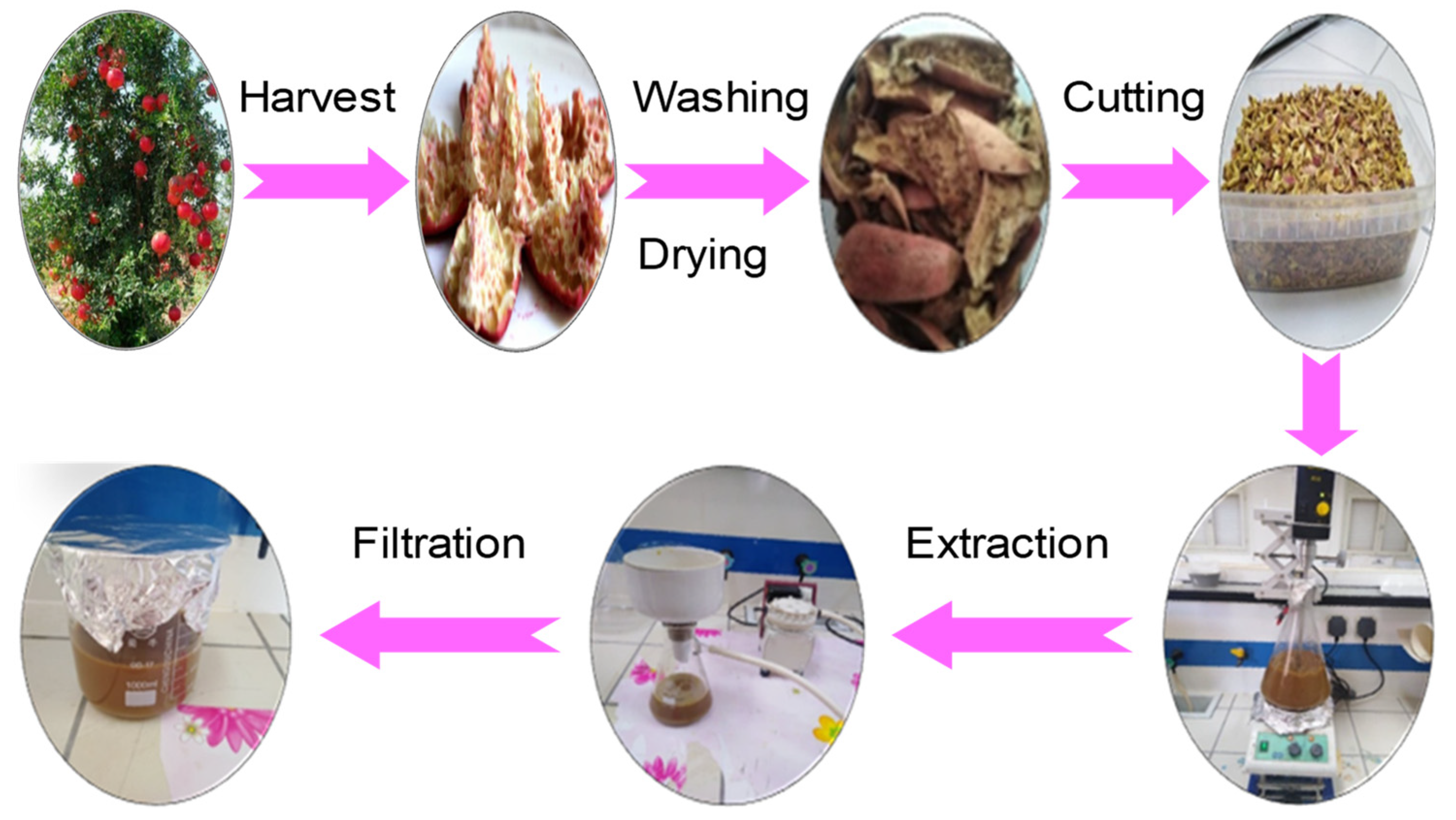
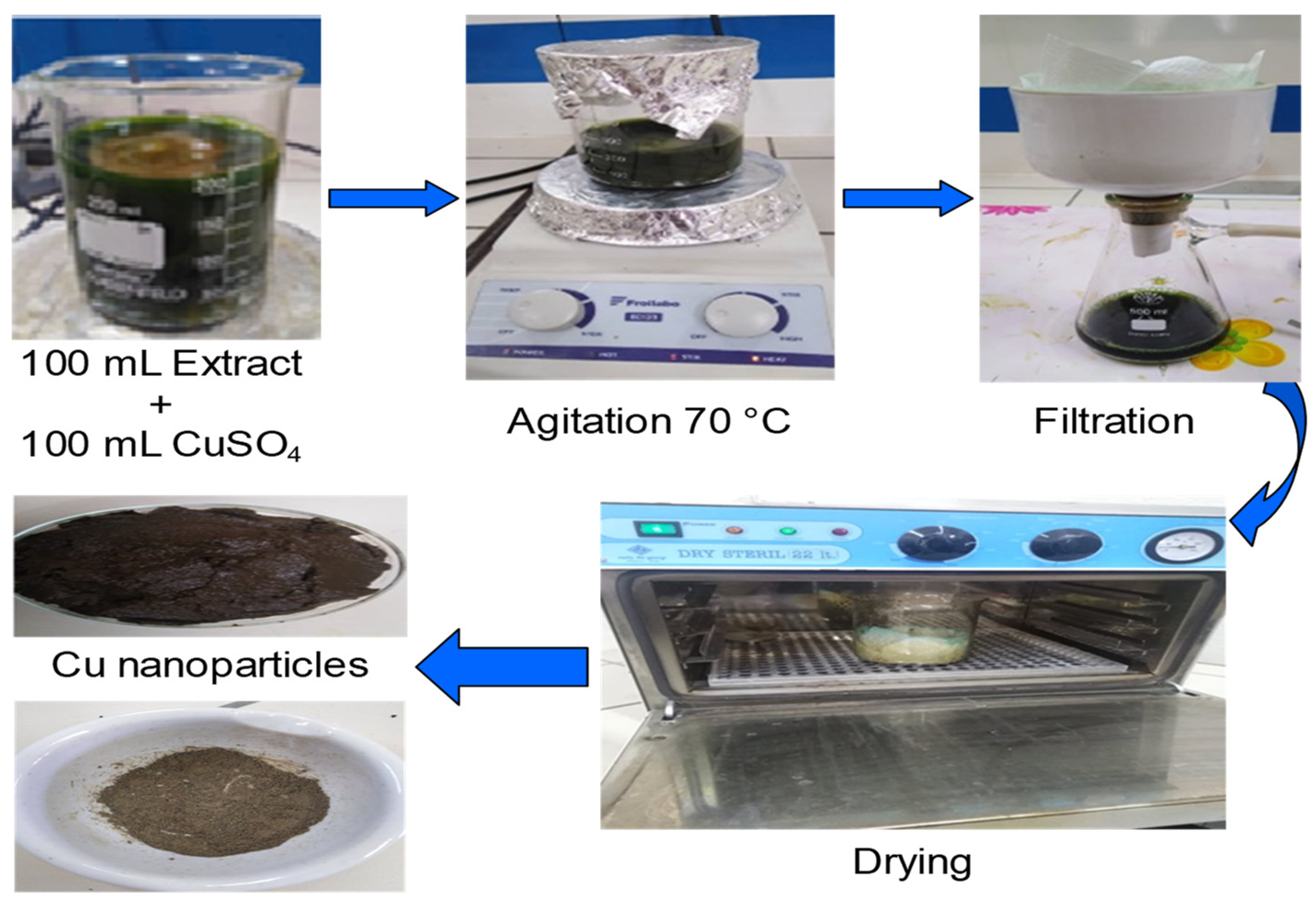
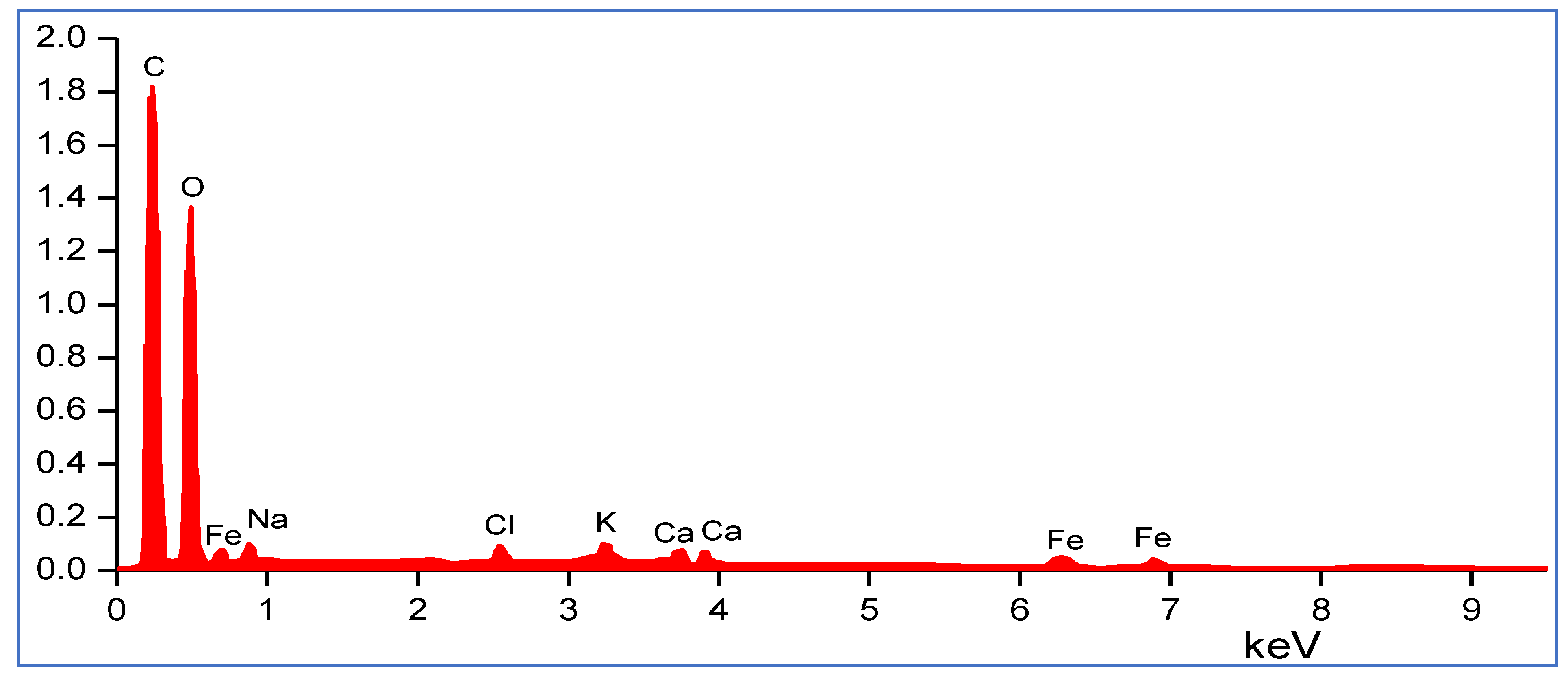
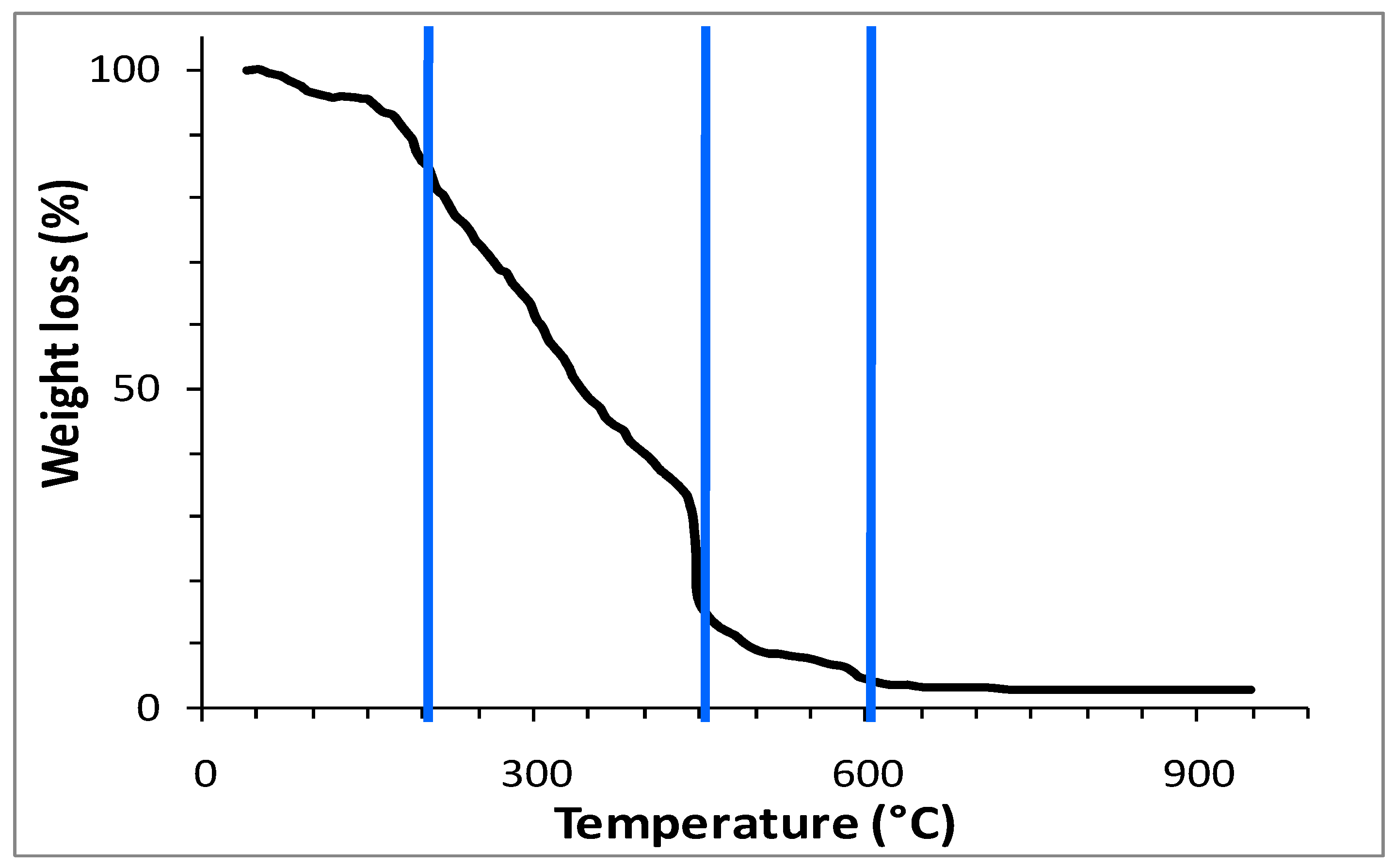
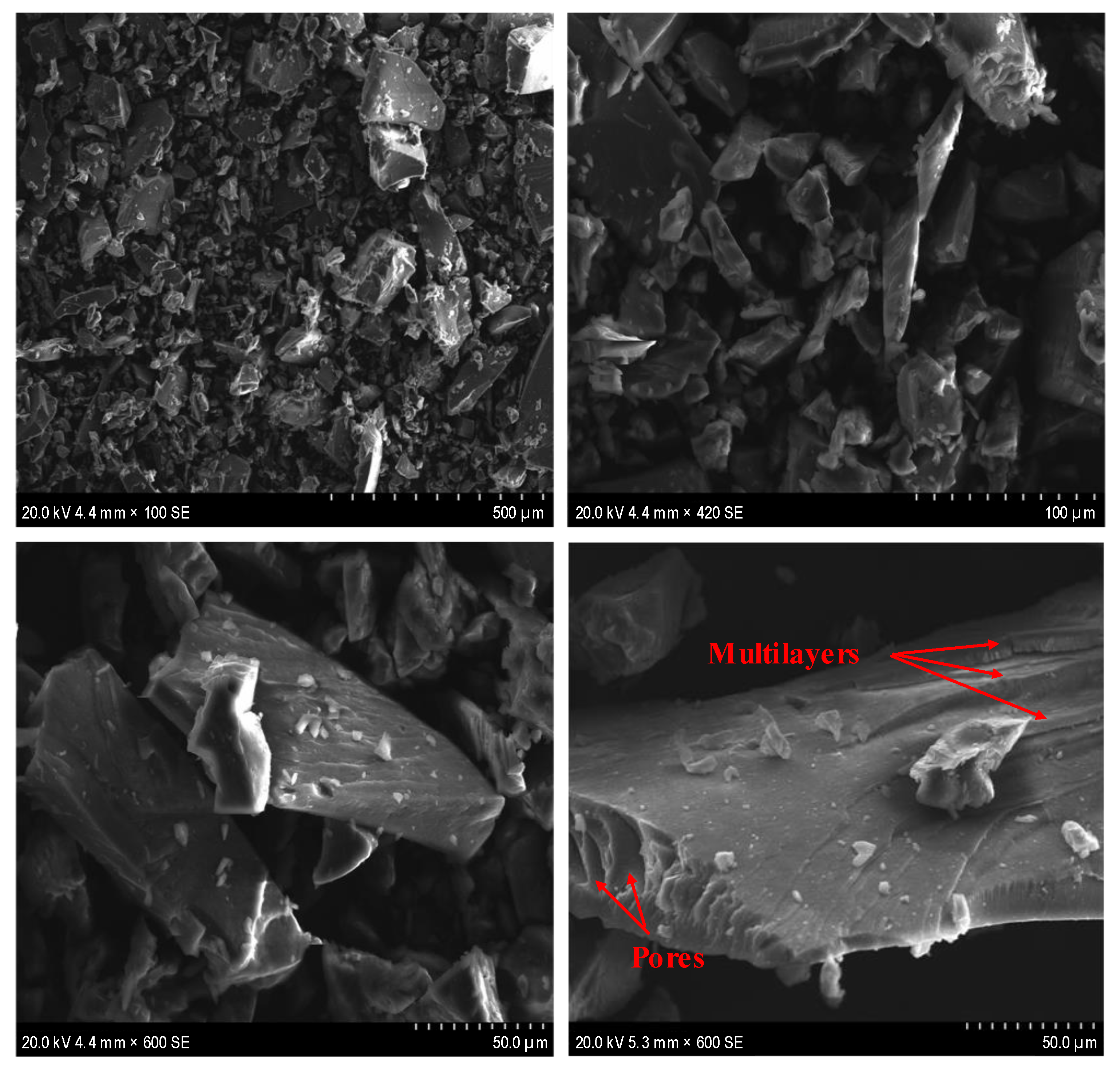
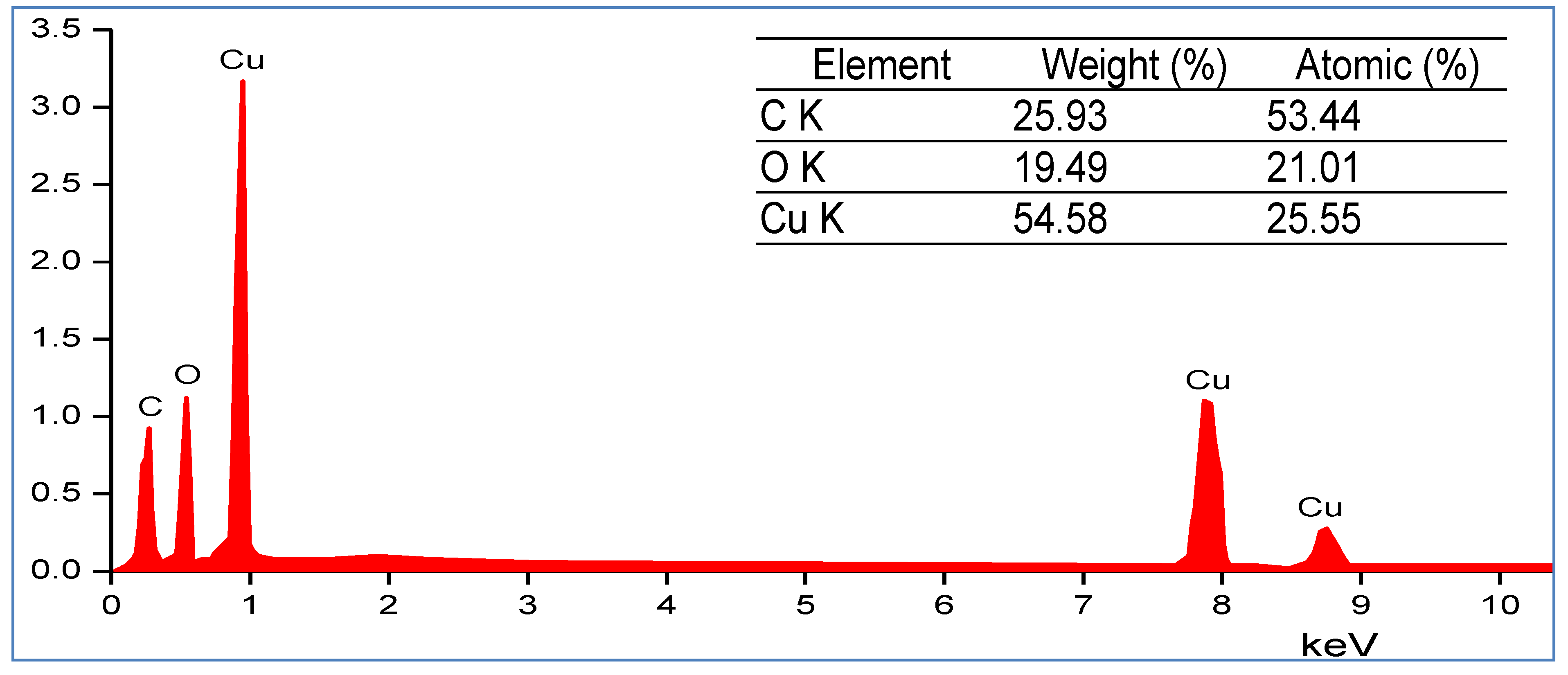
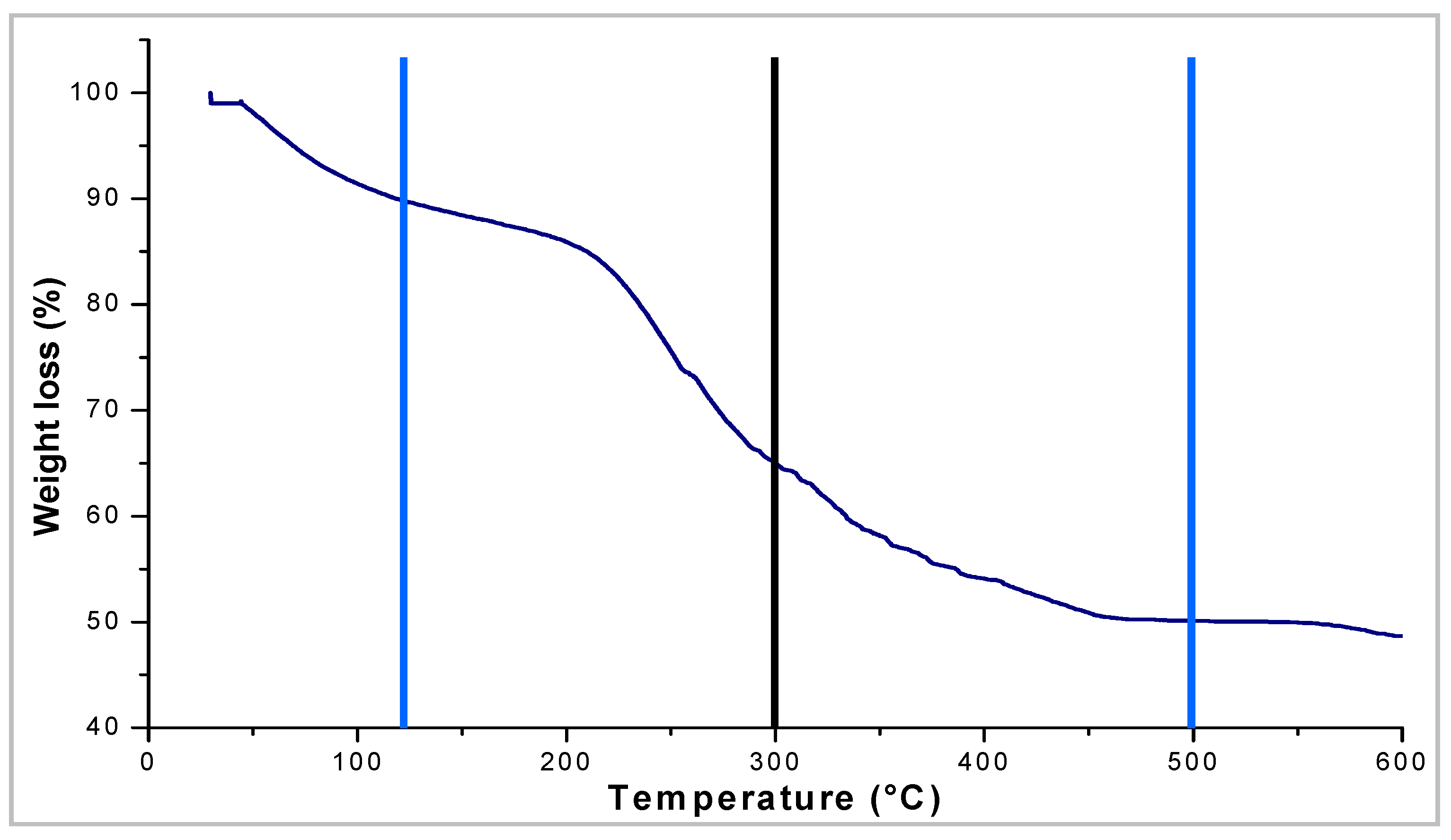

| Isotherm | Non-Linear Form | Linear Form |
|---|---|---|
| Langmuir | ||
| Freundlich | ||
| Temkin | ||
| Dubinin–Radushkevich |
| C. water | H. water | ET | 1% NaOH | Ash | Holocell. | Lignin | Cellulose | |
|---|---|---|---|---|---|---|---|---|
| Punica granatum bark | 28 | 37.6 | 46.5 | 32.4 | 4 | 16.2 | 22 | 7.9 |
| Wood | ||||||||
| Palmier Dattier [44] | n.a. | n.a. | 3 | n.a. | 6.5 | 59.5 | 27 | 33.5 |
| Olivier [45] | 15.5 | 17 | 10.4 | 30 | 1.4 | 65.8 | 15.6 | 41.5 |
| Tamarisk aphylla [46] | 12.8 | 19.0 | 4.5 | 18.5 | 3.5 | 50.0 | 30.0 | 39.0 |
| Prunus amygdalus [47] | 11.3 | 12.3 | 5 | 28.7 | 3.6 | 60.7 | 19.2 | 40.7 |
| Non-wood | ||||||||
| Rachis de Palmier Dattier [45] | 5 | 8.1 | 6.3 | 20.8 | 5 | 74.8 | 27.2 | 45 |
| Tiges de vignes [48] | 8.2 | 13.9 | 11.3 | 37.8 | 3.9 | 65.4 | 28.1 | 35 |
| FiguierBarbarie [49] | 24 | 36.3 | 8.8 | 29.6 | 5.5 | 64.5 | 4.8 | 53.6 |
| Ziziphus lotus [50] | n.a. | n.a. | 11 | n.a. | 1.49 | n.a. | 19.6 | 30.8 |
| Annual plants | ||||||||
| Alfa [51] | 9.1 | 11.1 | 7.9 | 19.4 | 5.1 | 69.7 | 17.71 | 47.6 |
| Stipagrostispungens [52] | 19.3 | 20.5 | 4.8 | 42.9 | 4.6 | 71 | 12 | 44 |
| Astragalus armatus [53] | 26.2 | 33 | 13 | 32.7 | 3 | 54 | 16.8 | 35 |
| Retama raetam [54] | 32 | 31.5 | 10 | 47 | 3.5 | 58.7 | 20.5 | 36 |
| Nitraria retusa [54] | 23 | 25.5 | 3 | 40 | 6.2 | 52 | 26.3 | 41 |
| Pithuranthoschloranthus [54] | 25 | 26.7 | 9.5 | 49 | 5 | 62 | 17.6 | 46.5 |
| qexp (mg g−1) | 24.9 | |
|---|---|---|
| Pseudo-first order | qcal (mg g−1) | 7.0 |
| k1 (min−1) | 0.0287 | |
| R2 | 0.7911 | |
| χ2 | 232.297 | |
| ∆q | 0.5199 | |
| RMSE | 15.2870 | |
| Pseudo-second order | qcal (mg g−1) | 25.6 |
| k2(g mg−1 min−1) | 0.0047 | |
| R2 | 0.9990 | |
| χ2 | 8.238 | |
| ∆q | 0.1125 | |
| RMSE | 4.8492 |
| Langmuir | qmax (mg g−1) | 28.7 |
| KL(L mg−1) | 6.96 | |
| RL | 0.0011–0.0279 | |
| R2 | 0.9892 | |
| χ2 | 1.9458 | |
| Δq | 0.0144 | |
| Freundlich | 1/n | 0.2294 |
| KF | 16.683 | |
| R2 | 0.7084 | |
| χ2 | 12.5882 | |
| Δq | 0.2419 | |
| Temkin | R2 | 0.8699 |
| B (J mol−1) | 3.3198 | |
| AT (L g−1) | 424.766 | |
| χ2 | 5.2396 | |
| Δq | 0.1960 | |
| Dubinin–Radushkevich | R2 | 0.9649 |
| B | 0.0215 | |
| qmax (mg g−1) | 27.709 | |
| χ2 | 6.7088 | |
| Δq | 0.0217 |
| Adsorbent | Adsorption Conditions | qmax (mg g−1) |
|---|---|---|
| Loofah fiber [59] | pH = 6.5; dose = 0.4 g/L; T = 25 °C | 18.2 |
| Bamboo [75] | pH of solution; dose =1 g/L; T = 25 °C | 20.4 |
| Graphene oxide [62] | pH = 7; dose = 0.1 g/L; T = 25 °C | 28.5 |
| Zeolite H-ZSM-5 [69] | pH = 4; dose = 1 g/L; T = 25 °C | 31.3 |
| Graphene sheets-CoFe2O4 nanparticles [71] | pH of solution; dose = 1 g/L; T = 25 °C | 47.2 |
| Activated carbon from Brachychiton Populneus fruit shell [64] | pH of solution; dose = 1 g/L; T = 20 °C | 67.9 |
| CoFe2O4/rGO nanocomposites [61] | pH of solution; dose = 0.25 g/L | 88.3 |
| (CNTs-NiFe2O4) [70] | pH of solution; dose = 1 g/L; T = 25 °C | 88.5 |
| CNTs [70] | pH of solution; dose = 1 g/L; T = 25 °C | 146 |
| Graphene sheets [71] | pH of solution; dose = 1 g/L; T = 25 °C | 203.5 |
| Activated bentonite [63] | pH of solution; dose = 0.1 g/L; T = 25 °C | 335.3 |
| Titanium dioxide [60] | pH = 6.6; dose = 1 g/L; T = 25 °C | 384.6 |
| CuO nanoparticles (this work) | pH of solution; dose = 2 g/L; T = 25 °C | 28.7 |
| Cycle | qads (mg g−1) | Adsorption (%) | Desorption (%) |
|---|---|---|---|
| 1 | 24.9 | 99.8 | 99.2 |
| 2 | 24.3 | 97.3 | 98.6 |
| 3 | 23.1 | 92.4 | 94.1 |
| 4 | 20.8 | 83.3 | 93.2 |
| 5 | 17.1 | 68.4 | 90.4 |
Publisher’s Note: MDPI stays neutral with regard to jurisdictional claims in published maps and institutional affiliations. |
© 2022 by the authors. Licensee MDPI, Basel, Switzerland. This article is an open access article distributed under the terms and conditions of the Creative Commons Attribution (CC BY) license (https://creativecommons.org/licenses/by/4.0/).
Share and Cite
ben Mosbah, M.; Alsukaibi, A.K.D.; Mechi, L.; Alimi, F.; Moussaoui, Y. Ecological Synthesis of CuO Nanoparticles Using Punica granatum L. Peel Extract for the Retention of Methyl Green. Water 2022, 14, 1509. https://doi.org/10.3390/w14091509
ben Mosbah M, Alsukaibi AKD, Mechi L, Alimi F, Moussaoui Y. Ecological Synthesis of CuO Nanoparticles Using Punica granatum L. Peel Extract for the Retention of Methyl Green. Water. 2022; 14(9):1509. https://doi.org/10.3390/w14091509
Chicago/Turabian Styleben Mosbah, Mongi, Abdulmohsen Khalaf Dhahi Alsukaibi, Lassaad Mechi, Fathi Alimi, and Younes Moussaoui. 2022. "Ecological Synthesis of CuO Nanoparticles Using Punica granatum L. Peel Extract for the Retention of Methyl Green" Water 14, no. 9: 1509. https://doi.org/10.3390/w14091509






